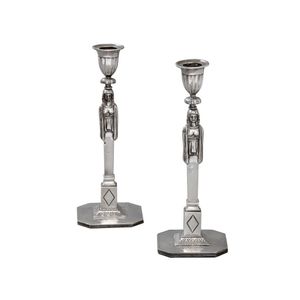Austrian Rothschild Silver Candlesticks, 1805
A pair of Austrian silver candlesticks, Vienna, 1805, each on a square chamfered base rising to a square shaft with draped female herm supporting the urn shaped fluted nozzle, the base engraved with the arms of the barons Rothschild, incised under the base: S. R. Height 23.5 cm, weight 753g. Provenance: probably Salomon Mayer von Rothschild (1774-1855). Private collection, Sydney. Other Notes: the Rothschilds were a famed banking family at the centre of international high finance during the rapid industrialisation of Europe in the nineteenth century. They were responsible for supporting many of the great railway schemes as well as complex government financing for massive infrastructure projects such as the Suez Canal. Originally from Frankfurt, by the end of the century the family had extensive households in London, Paris, Naples, Vienna, and the Netherlands, and their great wealth, combined with their love of Art, luxury, and fine living led to the creation of the expression le gout Rothschild - 'the Rothschild taste'. These elegant Viennese silver candlesticks of neo-classical design are dated 1805, the year that Napoleon's army stormed through Europe, ultimately occupying Vienna after the December defeat of the Austrian and Russian armies at the battle of Austerlitz. The fluted urn shaped nozzles are supported by draped female herms suggesting the caryatids (the sculpted figures serving in the place of columns) of the, Erechtheion in Athens, and the overall design is of a pared back classicism close to the spare linear designs of John Flaxman and a foretaste of Biedermeier. The base of each candlestick is engraved with the arms of the Rothschild family and their motto: 'Concordia, Integritas, Industria' (harmony, integrity, industry). This hereditary barony was granted to the five Rothschild Brothers, Amschel, Salomon, Nathan, Carl, and James, by the Austrian emperor Francis II in 1822. It is likely that these candlesticks belonged to Salomon Mayer von Rothschild (1774-1855). In 1820, Prince Metternich, Austrian Minister for foreign Affairs, entered into negotiations with the house of Rothschild for a large loan that was to take, the form of a lottery. The complicated arrangements for this enormous loan demanded the presence of a Rothschild in Vienna and thus Salomon, who had been handling Rothschild affairs with Austria, moved to the city and established a bank there. Salomon's close ties to Metternich were crucial in earning for the family a stake in the restructuring of Europe after the Napoleonic wars.
You must be a subscriber, and be logged in to view price and dealer details.
Subscribe Now to view actual auction price for this item
When you subscribe, you have the option of setting the currency in which to display prices to $Au, $US, $NZ or Stg.
This item has been sold, and the description, image and price are for reference purposes only.
- Bevel / Chamfer - In furniture making, a chamfered corner refers to a technique used to create a smooth, angled edge on the corner of a piece of furniture. This is typically done by cutting away a small portion of the corner at an angle, typically 45 degrees, creating a diagonal edge, rather than a sharp 90-degree angle. This technique can be used on various parts of a piece of furniture such as table legs, drawer fronts, or door frames. Chamfering can add visual interest to a piece and can help to soften the overall look of a piece of furniture. It is often used in conjunction with other techniques, such as rounding edges or using contrasting wood species to create a more elegant, sophisticated look. Chamfering is a simple way to add a touch of elegance to a piece of furniture and it is a common technique used by furniture makers.
- Incised - A record of a name, date or inscription, or a decoration scratched into a surface, usually of a glass or ceramic item with a blunt instrument to make a coarse indentation. Compare with engraving where the surface is cut with a sharp instrument such as a metal needle or rotating tool to achieve a fine indentation.
- Neo Classical - The period or style, known as "neo-classical", was based on Greek and Roman designs and motifs, and is usually associated with the influence of the four Adam brothers, but principally Robert Adam, the second oldest of the brothers, who were architects and designers, active in the latter half ot the 18th century (1760s to 1790s).
Born in Scotland in 1728, Robert Adam spent time in Italy studying and his designs are influenced by the finds made during the excavation of Pompei.
When he returned to England he became the Court Architect to George III (1738-1820).
In turn, designs by Adam then influenced Hepplewhite.
Neo-classical ornamentation is characterised by use of classical urns, palmettes, mythical creatures such as the sphinx and griffin, ram's heads, swags, scrolling foliage, and use of the Greek key pattern.
This item has been included into following indexes:
